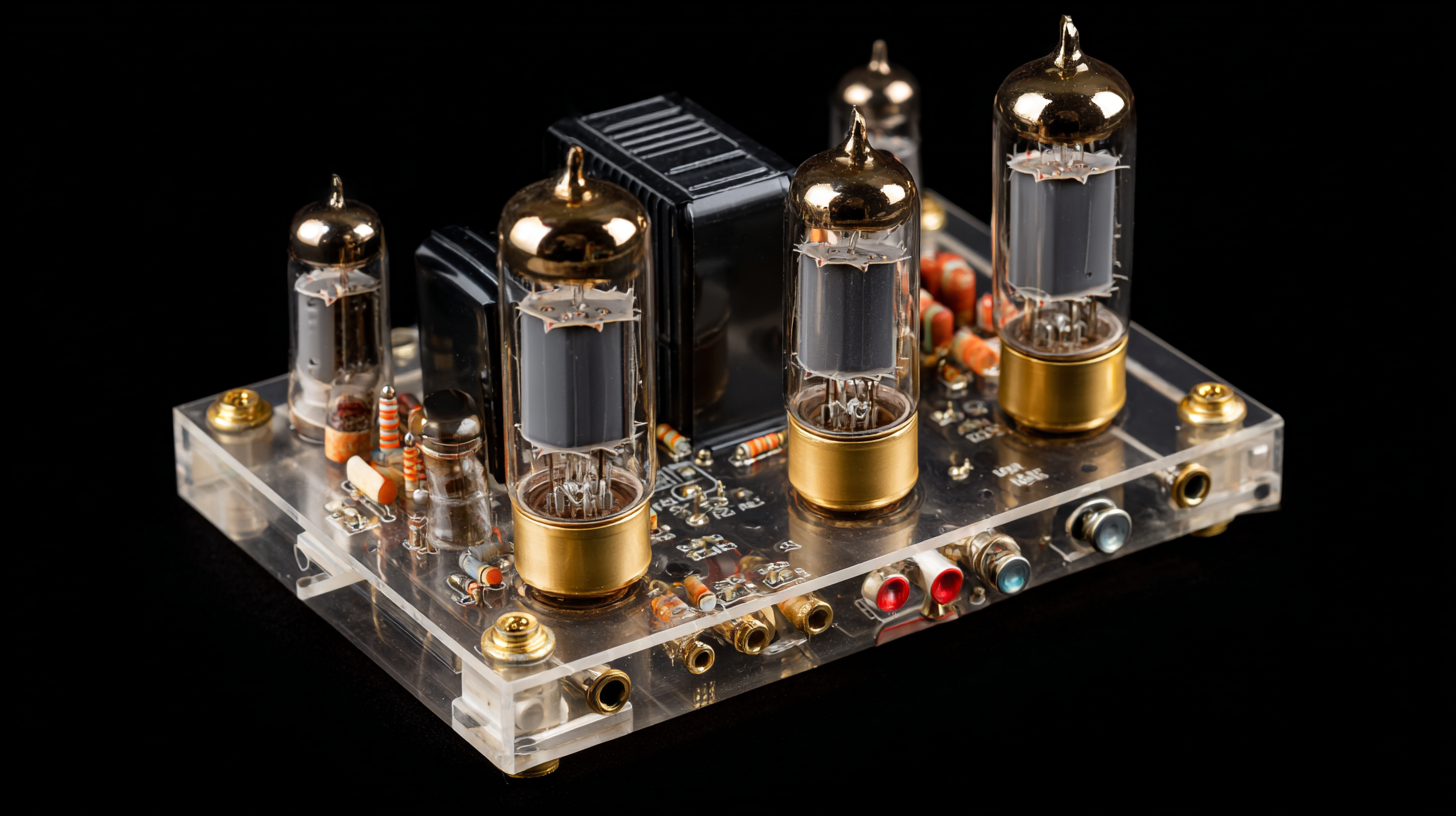In the rapidly evolving landscape of modern electronics, the role of Electron Tube Parts has become increasingly vital. As highlighted in a comprehensive report by Market Research Future, the global electron tube market is projected to exceed $1.2 billion by 2025, with a compound annual growth rate (CAGR) of 4.1%. This growth underscores the significance of electron tubes, which are essential components in various applications ranging from telecommunications to audio equipment. Electron Tube Parts, such as cathodes, control grids, and anodes, are pivotal in ensuring the reliability and efficiency of electronic devices. Their unique ability to handle high-frequency signals and provide superior performance in extreme conditions contributes to their sustained relevance in a digital era dominated by solid-state technology. Understanding the intricacies and functionalities of these components is crucial for professionals aiming to harness the full potential of modern electronic systems.

Electron tubes, also known as vacuum tubes, are vital components in many modern electronic devices. Understanding the basic parts of an electron tube is essential for grasping how they function. Key components include the cathode, anode, and control grid.
The cathode emits electrons when heated, creating a stream of electrons that flows towards the anode, which serves as the positive terminal that collects these electrons. The control grid modulates this electron flow, allowing for amplification and switching of signals, which is crucial in applications such as audio amplification and radio transmission.
Each part of an electron tube plays a significant role in its operation. The cathode's efficiency directly influences the tube's performance; its design must ensure adequate electron emission. The anode must be designed to handle the electron stream without overheating, as excessive heat can lead to failure. The control grid's voltage can finely adjust the electron flow, enabling precise control over the amplification process. By understanding these fundamental parts and their functions, one can appreciate the enduring significance of electron tubes in electronic systems, particularly in niche applications where their unique characteristics outperform modern solid-state devices.
In the realm of modern electronics, electron tubes continue to play a crucial role, despite the prevalence of solid-state devices. Key types of electron tubes, such as vacuum tubes, cathode ray tubes (CRTs), and gas discharge tubes, serve specific applications that highlight their unique capabilities. Vacuum tubes, for instance, are essential in high-power RF amplification and audio applications due to their ability to handle significant voltage and current. Meanwhile, CRTs have historically been the backbone of older television displays and oscilloscopes, while gas discharge tubes are widely used for voltage regulation and protection.
Tips: When selecting an electron tube for a project, consider the specific electrical characteristics required, such as operating voltage and frequency response. Ensure compatibility with your existing circuitry to avoid performance issues.
Furthermore, hybrid technologies combine the advantages of electron tubes and modern components. For example, the integration of vacuum tubes in guitar amplifiers provides a desirable warmth and richness to the sound that solid-state alternatives struggle to replicate. Additionally, advancements in manufacturing techniques have resulted in more robust and efficient electron tubes, making them suitable for both vintage restorations and new designs in the electronics landscape.
Tips: Keep an eye out for new developments in electron tube technology, as innovations can lead to improved performance and broader application possibilities in various fields, from telecommunications to medical devices.
| Type of Electron Tube | Main Function | Common Applications | Typical Specifications |
|---|---|---|---|
| Vacuum Tube | Amplification | Audio amplifiers, Radio transmitters | Power: 5W - 200W, Frequency: up to 1 GHz |
| Cathode Ray Tube (CRT) | Display technology | Television sets, Computer monitors | Screen Size: 15" - 40", Resolution: up to 1920x1080 |
| Thyratron | Switching | Pulse generators, High voltage applications | Voltage: up to 30kV, Current: up to 200A |
| Ionization Gauge | Pressure measurement | Vacuum systems, Scientific research | Pressure range: 10^-3 to 10^-9 Torr |
| Photomultiplier Tube (PMT) | Light detection | Medical imaging, Nuclear experiments | Gain: 10^6, Wavelength sensitivity: 200 - 900 nm |
The evolution of electron tube technology has significantly influenced modern electronics, despite the prevalence of solid-state devices. These tubes, once deemed obsolete, have regained popularity in niche applications, particularly in high-fidelity audio equipment and specialized communications technology. Their ability to handle high voltages and produce rich sound quality allows them to excel where other components might falter. As manufacturers revisit and refine these technologies, we see a blend of vintage aesthetics and modern engineering.
Tip: When considering electron tubes for your projects, evaluate the specific requirements of your device. This will help you determine which type of tube will deliver the best performance for audio quality or signal processing.
Manufacturers have invested in developing more efficient and reliable electron tubes, leading to innovations that imbue contemporary devices with improved durability and performance. This resurgence highlights not only the tubes' unique characteristics but also their adaptability to the evolving demands of technology. As consumers seek the warm sound profiles associated with analog systems, the marriage of electron tubes with modern components opens pathways for experimental designs and groundbreaking improvements.
Tip: Explore tube rolling—experimenting with different brands or types of tubes in audio equipment can yield fascinating differences in sound, allowing for a personalized listening experience.

The debate between electron tubes and solid-state components is pivotal in understanding modern electronics. Electron tubes, also known as vacuum tubes, have historically been essential in applications requiring high voltage and current, like audio amplifiers and radio transmitters. Their ability to handle high power and provide linear amplification makes them invaluable in specific contexts, especially in professional audio equipment where sound quality is paramount. The unique characteristics of these tubes, including their high gain and low noise, contribute to a warm, rich sound that many audiophiles prefer.
On the other hand, solid-state components, such as transistors and diodes, dominate the current electronics landscape due to their compact size, efficiency, and durability. They generate less heat, consume less power, and have a longer lifespan compared to electron tubes. Furthermore, solid-state devices are critical in digital technologies, offering superior integration capabilities and high-speed performance. While they excel in modern computing and communication systems, electron tubes maintain a niche role where their specific benefits can’t be replicated by solid-state technology. This comparative analysis underscores the importance of both technologies, highlighting the distinct scenarios where each excels.

The relevance of electron tubes in advanced electronics is experiencing a notable resurgence as technology evolves. Originally overshadowed by solid-state devices, electron tubes are now being rediscovered for their unique advantages, particularly in high-power applications and specific audio technologies. Their ability to handle extreme voltages and provide unmatched sound quality in high-fidelity audio equipment makes them a preferred choice for audiophiles and professionals alike. Furthermore, modern research into their functionality is unveiling potential applications in quantum computing and advanced communications systems, where their inherent characteristics could lead to significant breakthroughs.
As industries increasingly prioritize energy efficiency and performance reliability, the role of electron tubes is expanding. Innovations in materials and design are enhancing the durability and performance of these components, making them suitable for niche applications in aerospace, military, and medical fields. The development of more compact and efficient electron tubes could lead to integration into future electronic devices, meeting the demands of ever-evolving technology landscapes. Thus, as the electronics field progresses, electron tubes may reclaim a vital position, shaping the future of high-performance circuitry and challenging the dominance of traditional semiconductor technologies.






